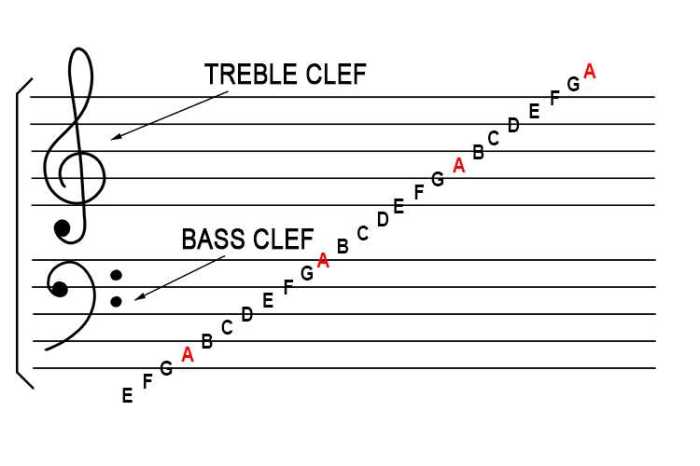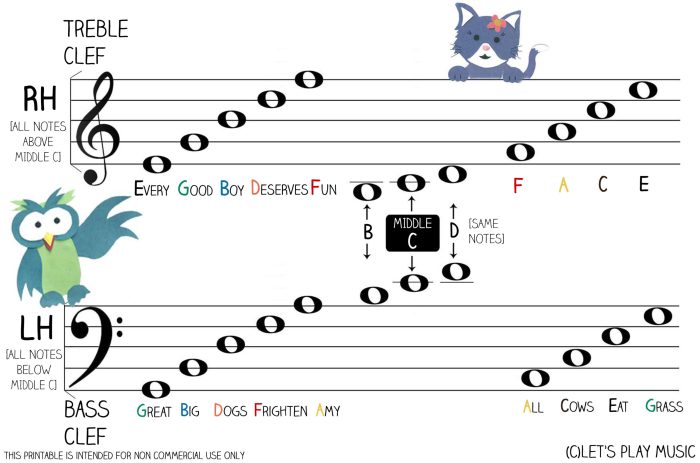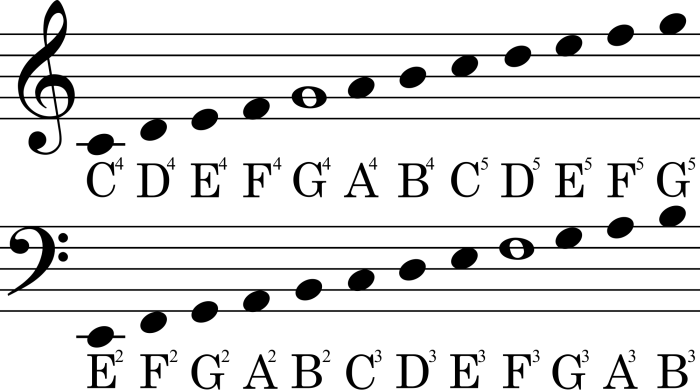Musical words treble clef 1 – Unravel the intricacies of the musical world with our comprehensive guide to the treble clef, the gatekeeper to a realm of enchanting melodies and harmonious notes. This enigmatic symbol, a cornerstone of musical notation, holds the key to unlocking the secrets of countless instruments and compositions.
From its historical roots to its practical applications, we’ll delve into the fascinating world of the treble clef, empowering you to navigate the musical landscape with confidence and precision.
Definition of Treble Clef

The treble clef, also known as the G clef, is a musical symbol used to indicate the pitch of notes on a musical staff. It is one of the three most commonly used clefs, along with the bass clef and the alto clef.
The treble clef is a stylized representation of the letter G. The two loops of the clef encircle the line that represents the note G4. The short vertical line at the bottom of the clef indicates the position of the middle C (C4).
Historical Origins and Evolution
The treble clef evolved from the medieval neumatic notation used in Gregorian chant. In this notation, a series of symbols called neumes were used to represent the contour of a melody. One of these neumes, called the “quilisma,” was used to indicate a high G.
Over time, the quilisma became stylized and eventually evolved into the modern treble clef.
Unique Shape and Differences from Other Clefs
The treble clef has a unique shape that distinguishes it from other clefs. The two loops of the clef encircle the line that represents the note G4, while the short vertical line at the bottom indicates the position of the middle C (C4).
This shape makes the treble clef easy to identify on a musical staff.
As we delve into the musical realm, let’s explore the intriguing world of treble clef 1. This enigmatic symbol holds the key to unlocking the secrets of higher-pitched notes. Now, for a quick detour, let’s check out this fascinating story about Kristin’s shopping spree.
Returning to our musical journey, treble clef 1 continues to guide us through the enchanting melodies and harmonies that enrich our lives.
The treble clef differs from other clefs in terms of the range of notes it represents. The treble clef is used to represent notes in the higher register, while the bass clef is used to represent notes in the lower register.
The alto clef is used to represent notes in the middle register.
Placement on the Musical Staff

The treble clef, also known as the G clef, is positioned at the beginning of the musical staff, indicating the pitch range of notes within the staff. It determines the absolute pitch of notes by defining the position of the note G4 on the staff.
The treble clef’s distinctive shape resembles a stylized letter “G” and encircles the second line of the staff. This placement establishes the G4 note as residing on that line, forming the basis for determining the pitch of other notes within the staff.
Pitch Range
The treble clef governs the pitch range of notes above middle C (C4). Notes written within the lines and spaces of the treble clef staff fall within the soprano and alto vocal ranges, as well as the higher registers of instruments like the violin, flute, and clarinet.
Examples of notes within the treble clef’s range include:
- G4 (second line)
- C5 (first space)
- F5 (third line)
- A5 (second space)
- D6 (fourth line)
Pitch Notation: Musical Words Treble Clef 1

Pitch notation in the treble clef is a system for representing the musical notes that can be played on instruments that use this clef, such as the piano, violin, and flute. The treble clef is placed on the left-hand side of the musical staff and indicates that the notes written on the staff are to be played at a higher pitch than those written in the bass clef.
Relationship between Staff Lines and Spaces and Corresponding Notes
The lines and spaces of the musical staff correspond to specific musical notes. The lines from bottom to top are named E, G, B, D, and F, while the spaces from bottom to top are named F, A, C, and E.
Each line and space represents a different pitch, with the lines representing the lower-pitched notes and the spaces representing the higher-pitched notes.
Use of Ledger Lines for Notes Outside the Staff’s Range
Ledger lines are short lines that are added above or below the staff to extend the range of notes that can be written. Ledger lines are used to write notes that are too high or too low to be written on the staff itself.
Ledger lines are named according to the line or space they are attached to, with ledger lines above the staff being called “above the staff” and ledger lines below the staff being called “below the staff.”
Transposition

Transposition in music refers to the act of changing the pitch of a musical composition while maintaining the interval relationships between the notes. It’s like moving a piece of music to a different key, making it higher or lower in pitch.
The treble clef plays a crucial role in transposing music. It helps musicians adjust the written notes to match the vocal range of singers or the playing range of instruments. For instance, a melody written in the treble clef can be transposed down to accommodate a lower vocal range by moving all the notes down a certain number of half steps.
Examples of Transposition Using the Treble Clef
- To transpose a melody up one whole step, move each note up one line or space on the treble clef.
- To transpose a melody down a minor third, move each note down three half steps, or one line and two spaces, on the treble clef.
- To transpose a melody down a perfect fourth, move each note down five half steps, or two lines and one space, on the treble clef.
Common Musical Instruments
The treble clef is widely used in musical notation for instruments that produce higher-pitched sounds. These instruments are commonly found in various genres of music, including classical, pop, jazz, and folk.
String Instruments
String instruments like the violin, viola, and cello commonly use the treble clef. These instruments produce high-pitched sounds when their strings are plucked or bowed, and the treble clef allows musicians to accurately notate the pitches they play.
-
-*Violin
The violin is a small, high-pitched string instrument that is often used in classical music. It has four strings that are tuned in fifths: G, D, A, and E. The treble clef is used to notate the pitches of the two highest strings, the A and E strings.
-*Viola
The viola is a larger, lower-pitched string instrument that is also used in classical music. It has four strings that are tuned in fifths: C, G, D, and A. The treble clef is used to notate the pitches of the two highest strings, the D and A strings.
-*Cello
The cello is a large, low-pitched string instrument that is used in both classical and jazz music. It has four strings that are tuned in fifths: C, G, D, and A. The treble clef is used to notate the pitches of the two highest strings, the D and A strings.
Woodwind Instruments
Woodwind instruments like the flute, clarinet, and saxophone also commonly use the treble clef. These instruments produce sound when air is blown through a mouthpiece, and the treble clef allows musicians to accurately notate the pitches they play.
-
-*Flute
The flute is a woodwind instrument that is made of metal or wood. It has a cylindrical bore and a mouthpiece that is blown across. The flute produces a clear, bright sound, and the treble clef is used to notate the pitches it plays.
-*Clarinet
The clarinet is a woodwind instrument that is made of wood or plastic. It has a cylindrical bore and a single reed mouthpiece. The clarinet produces a warm, mellow sound, and the treble clef is used to notate the pitches it plays.
-*Saxophone
The saxophone is a woodwind instrument that is made of metal. It has a conical bore and a single reed mouthpiece. The saxophone produces a rich, full sound, and the treble clef is used to notate the pitches it plays.
Brass Instruments
Brass instruments like the trumpet and trombone can also use the treble clef, particularly in their higher registers. These instruments produce sound when air is blown through a mouthpiece, and the treble clef allows musicians to accurately notate the pitches they play in their higher ranges.
-
-*Trumpet
The trumpet is a brass instrument that is made of metal. It has a cylindrical bore and a mouthpiece that is blown into. The trumpet produces a bright, piercing sound, and the treble clef is used to notate the pitches it plays in its higher register.
-*Trombone
The trombone is a brass instrument that is made of metal. It has a cylindrical bore and a slide that is used to change the length of the instrument. The trombone produces a rich, mellow sound, and the treble clef is used to notate the pitches it plays in its higher register.
Keyboard Instruments, Musical words treble clef 1
Keyboard instruments like the piano and organ also commonly use the treble clef for their higher-pitched notes. These instruments produce sound when keys are pressed, and the treble clef allows musicians to accurately notate the pitches they play.
-
-*Piano
The piano is a keyboard instrument that has a series of hammers that strike strings when keys are pressed. The piano produces a wide range of pitches, and the treble clef is used to notate the pitches of the higher-pitched notes.
-*Organ
The organ is a keyboard instrument that has a series of pipes that produce sound when air is blown through them. The organ produces a wide range of pitches, and the treble clef is used to notate the pitches of the higher-pitched notes.
Variations of the Treble Clef

The treble clef, also known as the G clef, has undergone several variations throughout history, each serving a specific purpose or addressing particular musical needs.
Variations of the treble clef include the French violin clef and the G clef. These variations differ in their placement on the staff and the range of pitches they represent.
French Violin Clef
The French violin clef is a variation of the treble clef that is placed on the third line of the staff. It is commonly used in French music for solo violin parts and is also known as the “clef de sol”.
The French violin clef indicates that the note written on the third line is G4, an octave higher than the G clef.
G Clef
The G clef is the most common variation of the treble clef and is placed on the second line of the staff. It indicates that the note written on the second line is G4, the same pitch as the French violin clef but an octave lower.
FAQs
What is the purpose of the treble clef?
The treble clef, also known as the G clef, is primarily used to indicate the higher-pitched notes in musical notation, making it suitable for instruments with higher ranges, such as violins, flutes, and soprano voices.
How do I read notes on the treble clef?
The treble clef assigns a specific pitch to each line and space on the musical staff. The lines, from bottom to top, represent E, G, B, D, and F, while the spaces represent F, A, C, and E.
What instruments commonly use the treble clef?
Instruments that typically employ the treble clef include violins, violas, flutes, oboes, clarinets, trumpets, and soprano and alto voices.